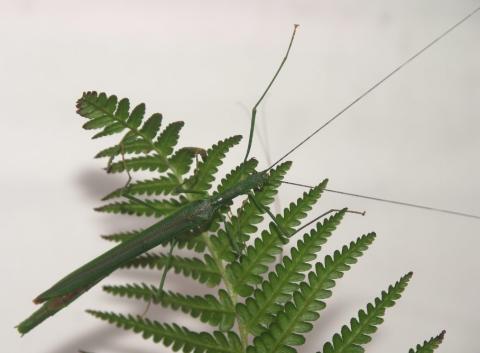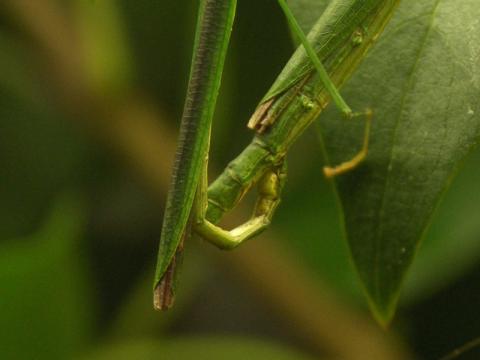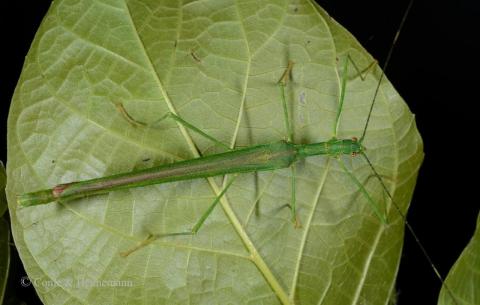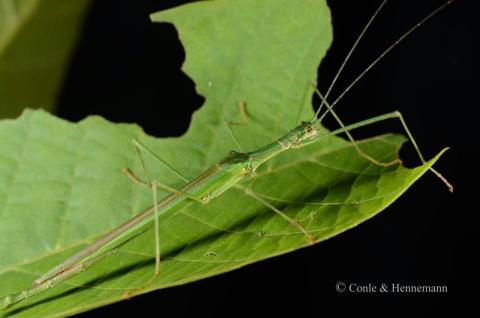
Genus
Species
Stock
CLP
557
PSG
376
Culture status
Probably lost
Foodplants
Lonicera nitida
English Plantain (Plantago lanceolata)
Lilac (Syringa vulgaris)
Abelia sp.
Symphoricarpos albus
Viburnum tinus
Weigelia sp.
Gonzalagunia hirsuta
Privet (Ligustrum spp.)
Breeding notes
(by Yannick Bellanger, ASPER, France)
General Notes
- Redtenbacher (1906) described this species from Venezuela
- it seems that this is the first successful culture of a species in the family
Stratocleinae - Yannick Bellanger described the female and the egg for the first time
_________________
Culture History
- 2009 - first successful culture by Y. Bellanger (only 3 hatched nymphs from 10 eggs, 1 male and 2 females)
- 2012 – first distribution of surplus by ASPER as Brizoides amabilis
_________________
Origin
- Tobago
_________________
Females
- winged, they fly very well
- about 6 cm long
- body coloration green and wings orange
- antennae longer than the body
- ocelli visible
_________________
Males
- winged, they fly very well
- between 4.5 and 5 cm long
- body coloration green and wings orange
- antennae longer than the body
- ocelli visible
_________________
Nymphs
- light brown body
- when disturbed, they show a small white mark under their abdomen
_________________
Eggs
- light grey when freshly laid, after they become light brown
- total length is about 3.0 mm
- very lengthened micropylar plate
- flat operculum
_________________
Food Plants
- honeysuckle (Lonicera sp.)
common and winter green garden plant, is well accepted by nymphs and adults - english plantain (Plantago lanceolata)
very common and winter green small herbaceous plant, well accepted by nymphs and adults. Interesting especially for freshly hatched nymphs which are very small - lilac (Syringa vulgaris)
common garden plant, well accepted by nymphs and adults but only possible from spring to autumn as it is not a winter green plant - Abelia sp.
garden plant, well accepted by nymphs and adults - Symphoricarpos albus
garden plant, well accepted by nymphs and adults - Viburnum tinus
garden plant, accepted especially by adults - Weigelia sp.
garden plant - Gonzalagunia hirsuta
natural foodplant - privet (Ligustrum vulgare)
well accpeted (info by Anthony Lefevre, France)
_________________
Behaviour
- nocturnal species, nymphs spend the day time in the branchs and under leaves of Gonzalagunia hirsuta. Adults fly very well on night.
- matings can occur for a quite long time, even during the day, but males do not stay with the same female
- when disturbed, nymphs and adults spray an odorant liquid which smells citronella. Adults also open quickly their orange wings in order to frighten and to fly away
- when they escape, adults are attracted by the light
- adults sometime move during the day
- females lay between 2 and 3 eggs per day, which are thrown at random on the ground
_________________
Development
- incubation time (on wet peat at 18-20°C) is between 4 and 7 months
- males are adults (at 18-22°C) in 3.5 months, females in 3.5 to 4 months
_________________
Breeding Notes
- I keep this species in a humid cage with a little bit of ventilation
- nymphs can be kept with adults
- I spray water on the ground about 2 times per week and sometime on the leaves
- this species likes a high level of humidity
_________________
References
- Langlois & Bellanger, « Inventaire des Phasmatodea de Tobago », Bulletin de la Société entomologique de France, 117 (1), 2012: 91-110
- Phasmida Species Files (www.phasmida.orthoptera.org)



























